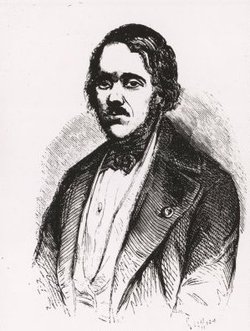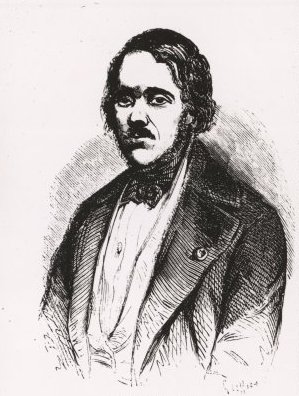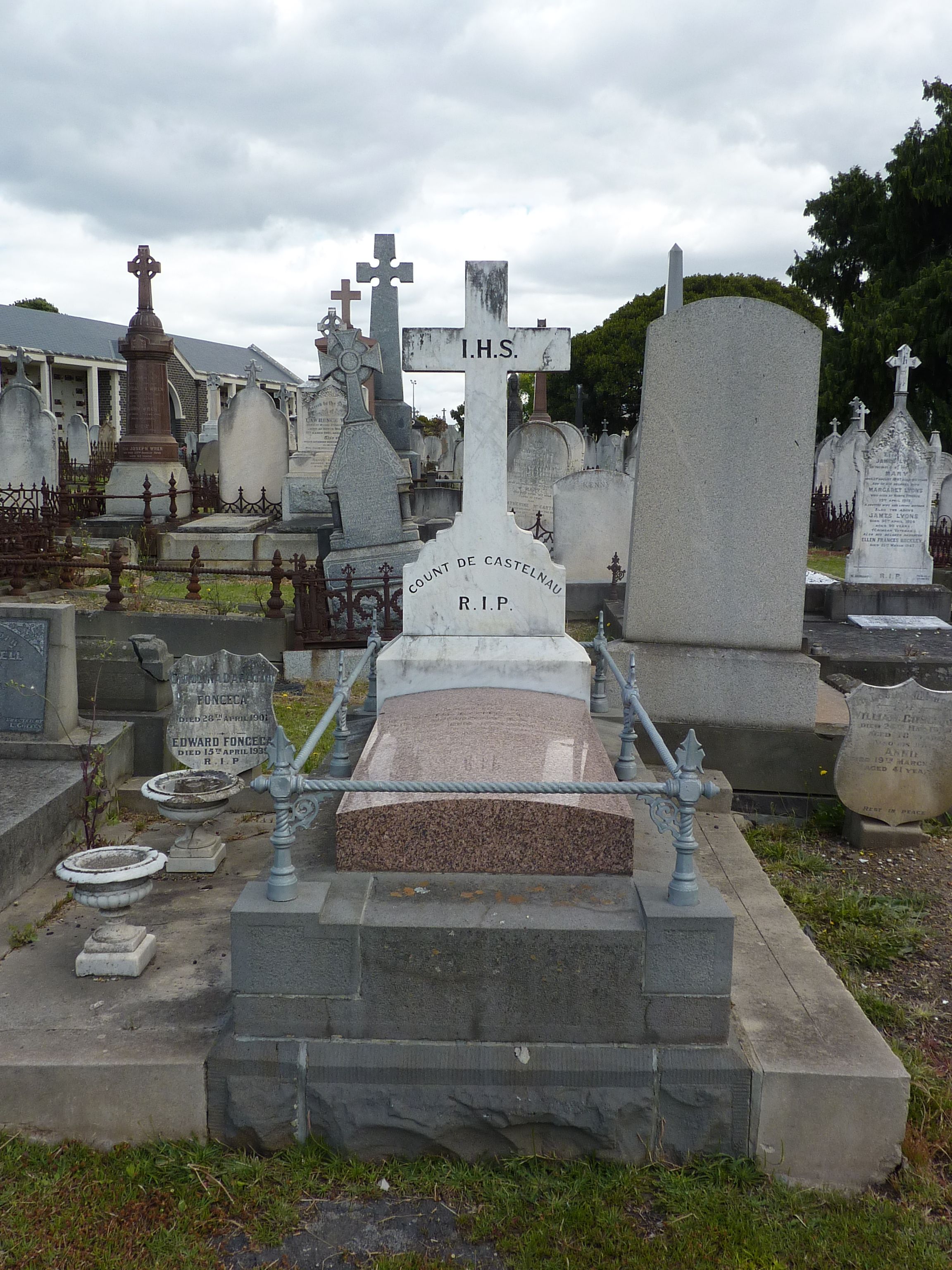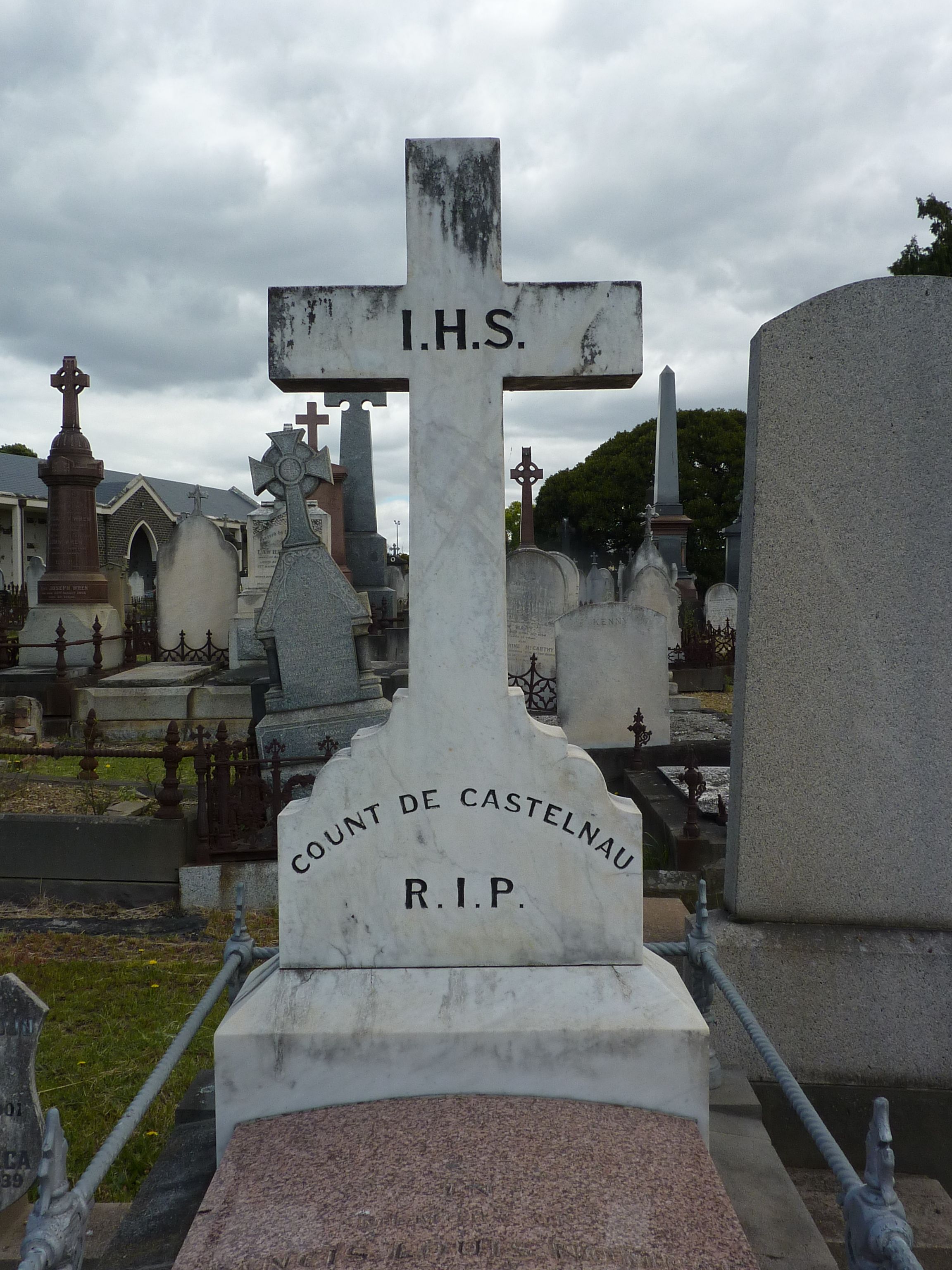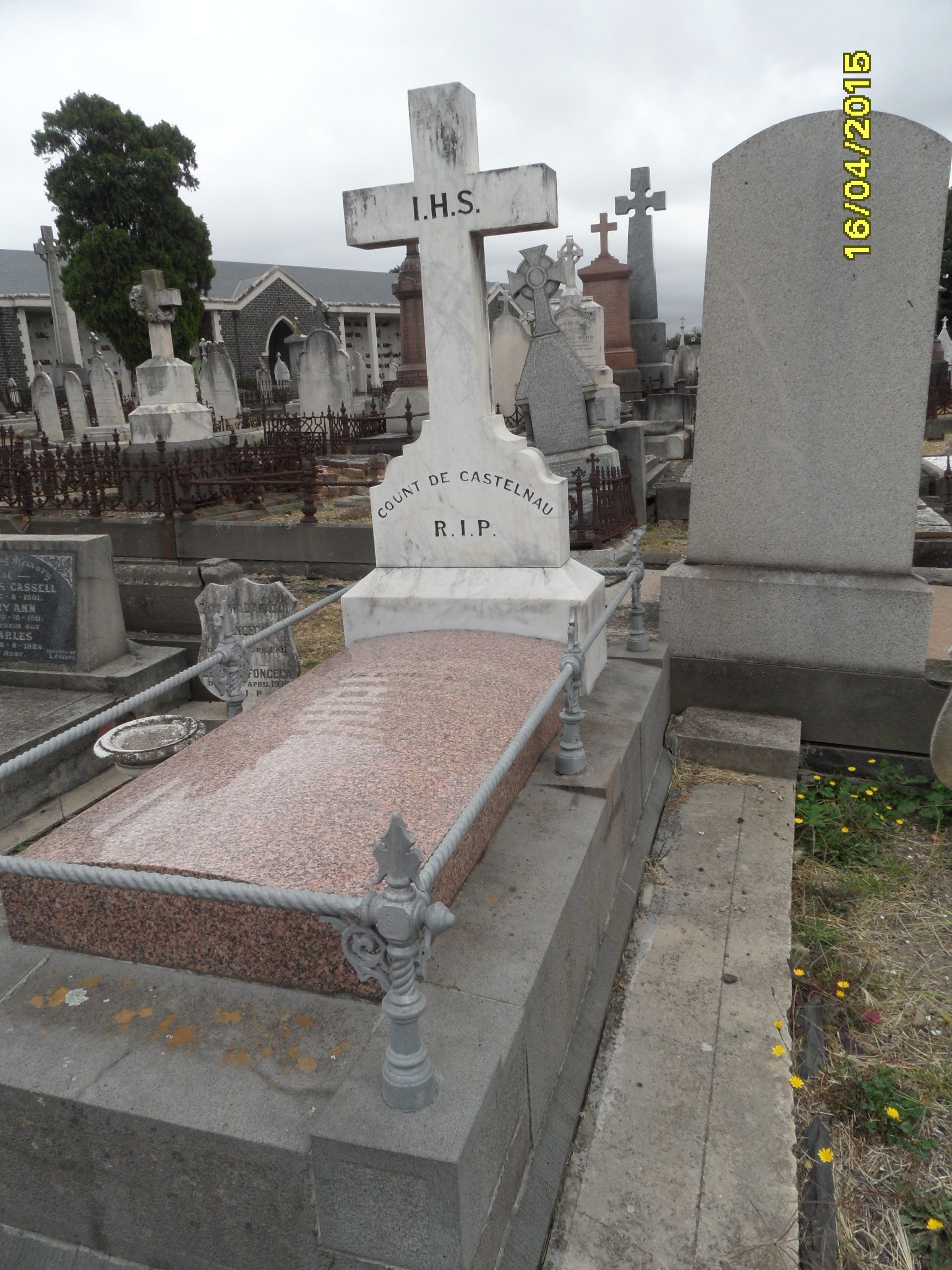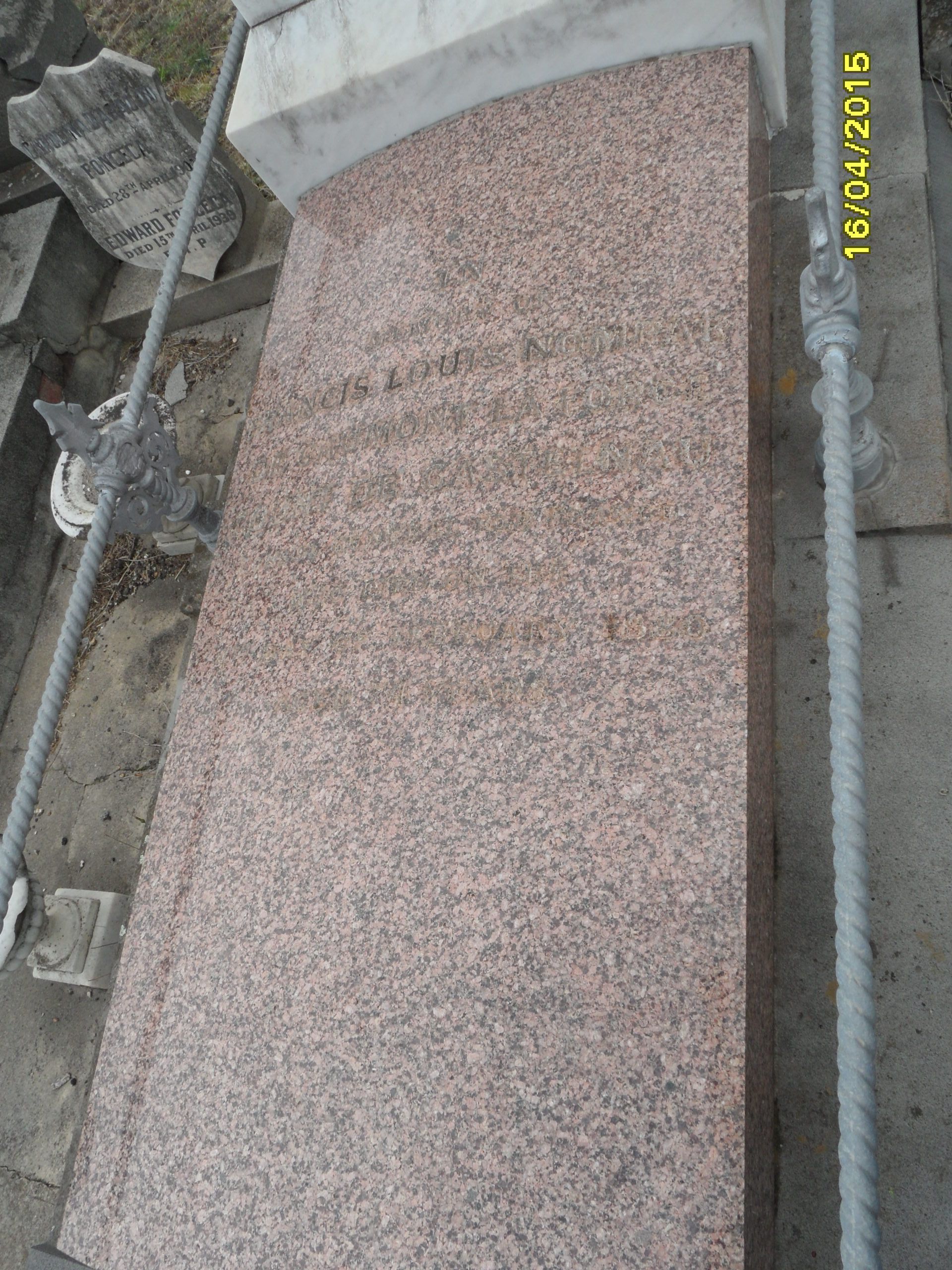Francis Louis Nompar de Caumont de La Porte de Castelnau was a French Count and appointed as French Consul to Melbourne, Australia in March 1863.His arrival was reported in the Argus Newspaper of the 17th June 1863 where it listed the Count de Castelnau (Consul General);Madame Fonceca and child and servant Mr Combe.
The Register of Births Deaths and Marriages in Melbourne for 1880, records that the Count of Castelnau died at Apsley Place, Gisborne Street, East Melbourne from the effects of ‘dysentery exhaustion’.
His age was given as 74 years, his parents were unknown, his birthplace was listed as London, and it was noted that he had been resident two years in New South Wales and
sixteen years in Victoria. No record of any marriage or the existence of children is included in the register of his death, likewise his death notice in the Melbourne press gives no clue as to any family in Melbourne or elsewhere.
Australian Town & Country Journal offers the following view of his life (14 Feb 1880)
On February 4, at Apsley Place, East Melbourne; there died a remarkable French gentleman, Francis Louis Nompar do Gramont La Force, Count do Castelnau, late Consul General for France.
The Argus of Thursday says the Count de Castelnau was for many years French consul at Melbourne.The deceased gentleman was an ardent student of natural history, and had pursued his studies in the various parts of the world whither his official duties led him. He contributed many papers on ichthyology to various scientific bodies, and was the author of some works on the same subject. In early life he passed about five years in Canada and the United States, and was afterwards appointed director of the scientific expedition sent by Louis Philippe, the King of the French, to South America. After the revolution of 1848, he was appointed French consul at Bahia, and from there he was transferred to the Cape of Good Hope, where he remained three years, during which time he wrote a work entitled " Memoire sur los Poissons do l'Afrique Australe." From the Cape he was sent by the French Government to establish a French consulate at Siam, whence he visited Ceylon, Malacca, and the Straits Settlements. He then returned to Europe, and commenced to put his voluminous notes in order, when he made the disheartening discovery that while he had been temporarily disabled his servant had been for more than a month in the habit of using the sheets of paper on which he had bestowed so much time and labour to light the fires. He disposed of the remainder of his notes and drawings to Professor Lacordaire, and about 1862 arrived in Melbourne, where he has since resided. Count Castelnau was an active member of the Zoological and Acclimatization Society of Victoria. He contributed several valuable papers on the fishes of Australia, which have been published by the society and are recognized by naturalists as works of authority on the subject.
Refer to the grave of Caroline Fonceca for more details on her relationship with the Count.∼Francis Louis' correct title is 'Count' De Castlenau.
He was the Consul General for France in Australia as well as a Naturalist. Several Australian insects have been named after him.
Count Francis John died at his home at Apsley Terrace, Eastern Hill (now known as East Melbourne, a fashionable area even today) and he left an estate valued at Pounds 17, 107; a lot of money in 1880.
He was buried in the Melbourne General Cemetery on 6 February 1880 in the Roman Catholic Section. The Russian and German Consuls were also in attendance.
Francis Louis Nompar de Caumont de La Porte de Castelnau was a French Count and appointed as French Consul to Melbourne, Australia in March 1863.His arrival was reported in the Argus Newspaper of the 17th June 1863 where it listed the Count de Castelnau (Consul General);Madame Fonceca and child and servant Mr Combe.
The Register of Births Deaths and Marriages in Melbourne for 1880, records that the Count of Castelnau died at Apsley Place, Gisborne Street, East Melbourne from the effects of ‘dysentery exhaustion’.
His age was given as 74 years, his parents were unknown, his birthplace was listed as London, and it was noted that he had been resident two years in New South Wales and
sixteen years in Victoria. No record of any marriage or the existence of children is included in the register of his death, likewise his death notice in the Melbourne press gives no clue as to any family in Melbourne or elsewhere.
Australian Town & Country Journal offers the following view of his life (14 Feb 1880)
On February 4, at Apsley Place, East Melbourne; there died a remarkable French gentleman, Francis Louis Nompar do Gramont La Force, Count do Castelnau, late Consul General for France.
The Argus of Thursday says the Count de Castelnau was for many years French consul at Melbourne.The deceased gentleman was an ardent student of natural history, and had pursued his studies in the various parts of the world whither his official duties led him. He contributed many papers on ichthyology to various scientific bodies, and was the author of some works on the same subject. In early life he passed about five years in Canada and the United States, and was afterwards appointed director of the scientific expedition sent by Louis Philippe, the King of the French, to South America. After the revolution of 1848, he was appointed French consul at Bahia, and from there he was transferred to the Cape of Good Hope, where he remained three years, during which time he wrote a work entitled " Memoire sur los Poissons do l'Afrique Australe." From the Cape he was sent by the French Government to establish a French consulate at Siam, whence he visited Ceylon, Malacca, and the Straits Settlements. He then returned to Europe, and commenced to put his voluminous notes in order, when he made the disheartening discovery that while he had been temporarily disabled his servant had been for more than a month in the habit of using the sheets of paper on which he had bestowed so much time and labour to light the fires. He disposed of the remainder of his notes and drawings to Professor Lacordaire, and about 1862 arrived in Melbourne, where he has since resided. Count Castelnau was an active member of the Zoological and Acclimatization Society of Victoria. He contributed several valuable papers on the fishes of Australia, which have been published by the society and are recognized by naturalists as works of authority on the subject.
Refer to the grave of Caroline Fonceca for more details on her relationship with the Count.∼Francis Louis' correct title is 'Count' De Castlenau.
He was the Consul General for France in Australia as well as a Naturalist. Several Australian insects have been named after him.
Count Francis John died at his home at Apsley Terrace, Eastern Hill (now known as East Melbourne, a fashionable area even today) and he left an estate valued at Pounds 17, 107; a lot of money in 1880.
He was buried in the Melbourne General Cemetery on 6 February 1880 in the Roman Catholic Section. The Russian and German Consuls were also in attendance.
Family Members
Advertisement
Explore more
Sponsored by Ancestry
Advertisement
